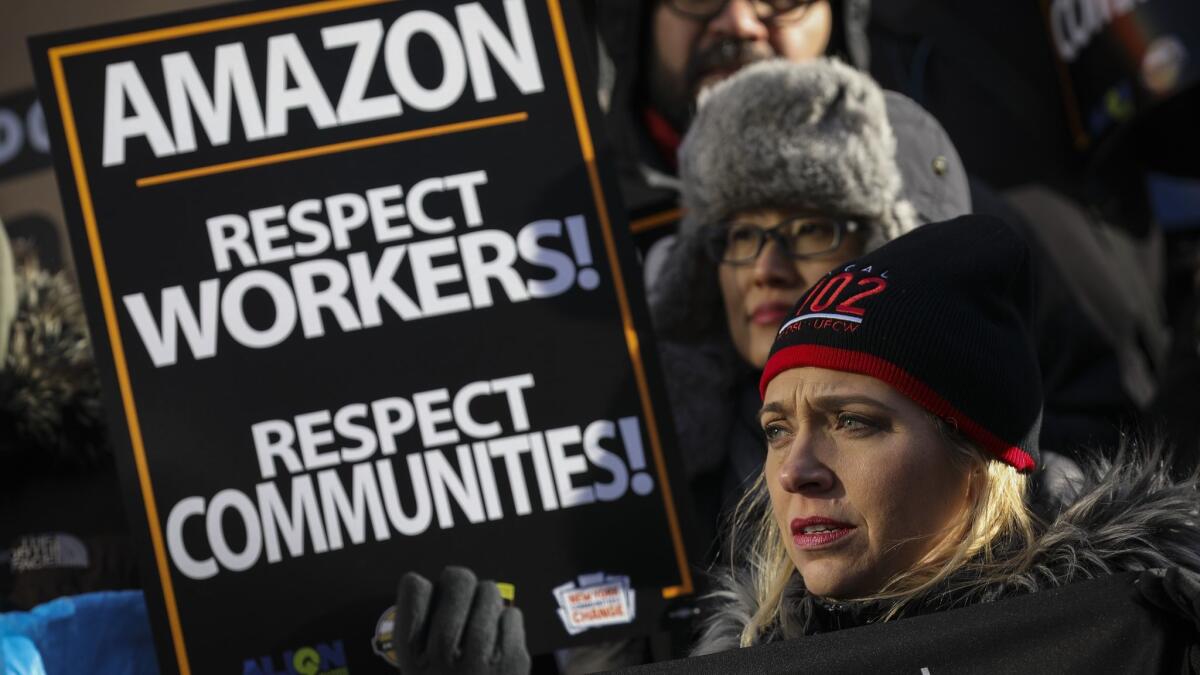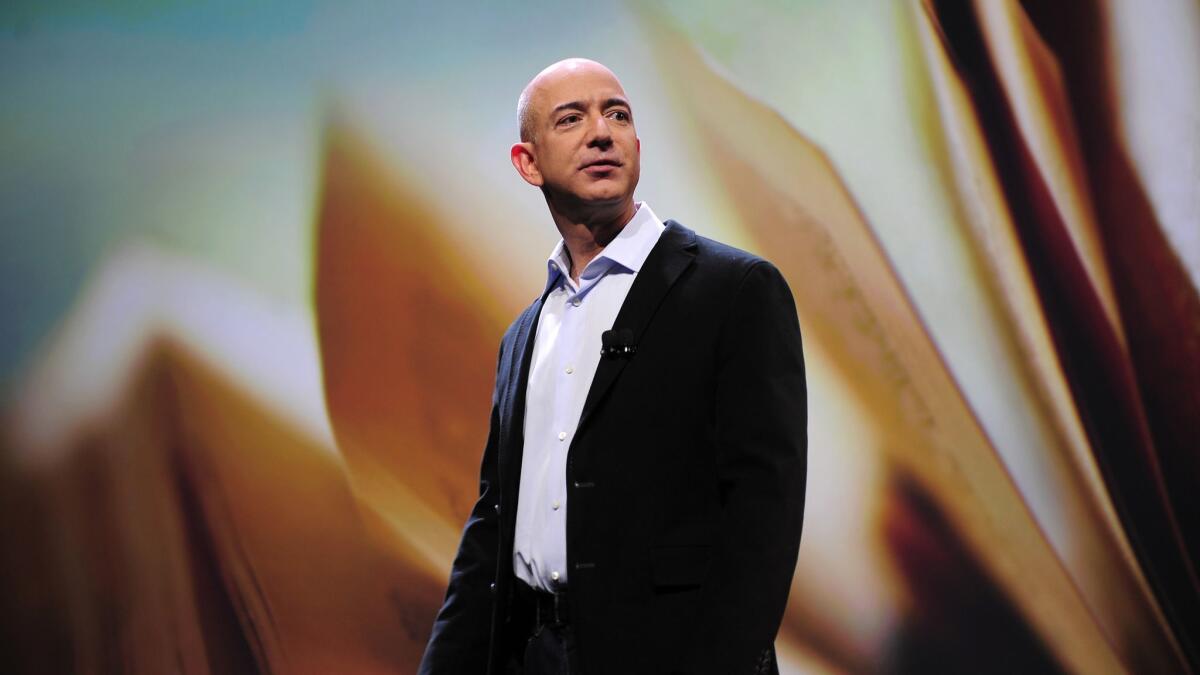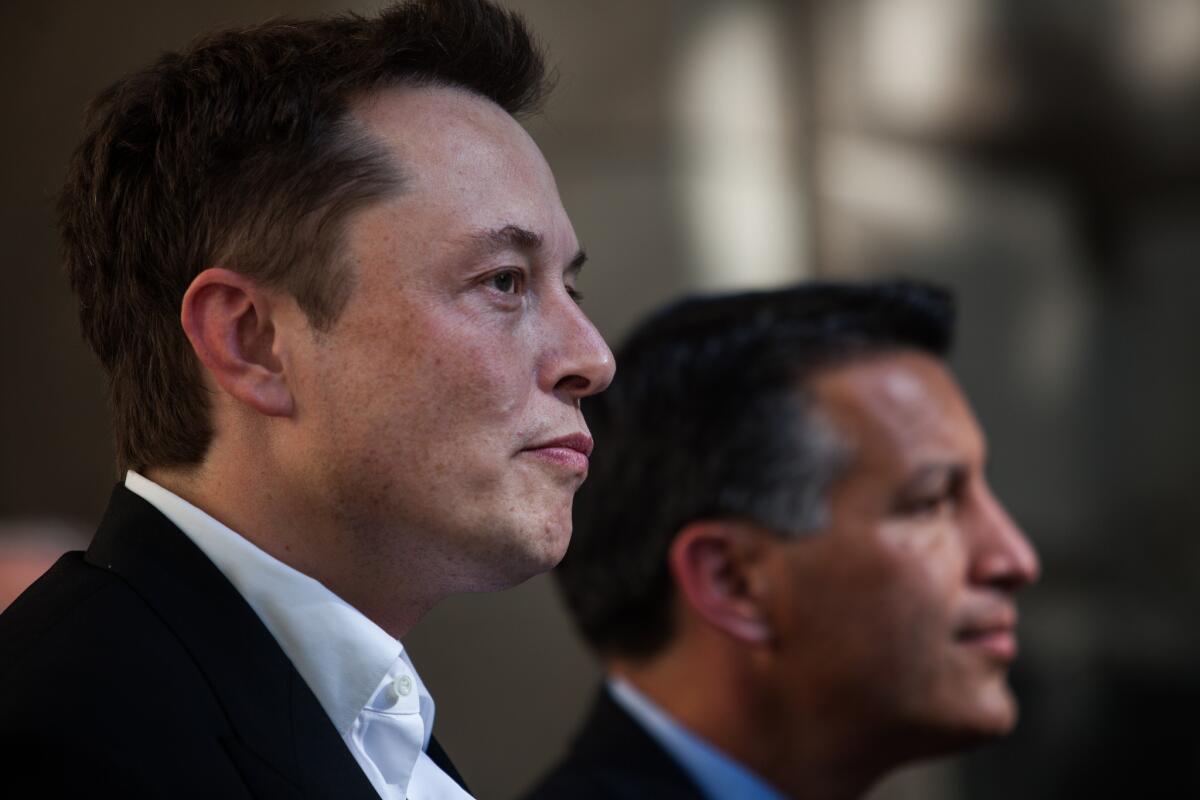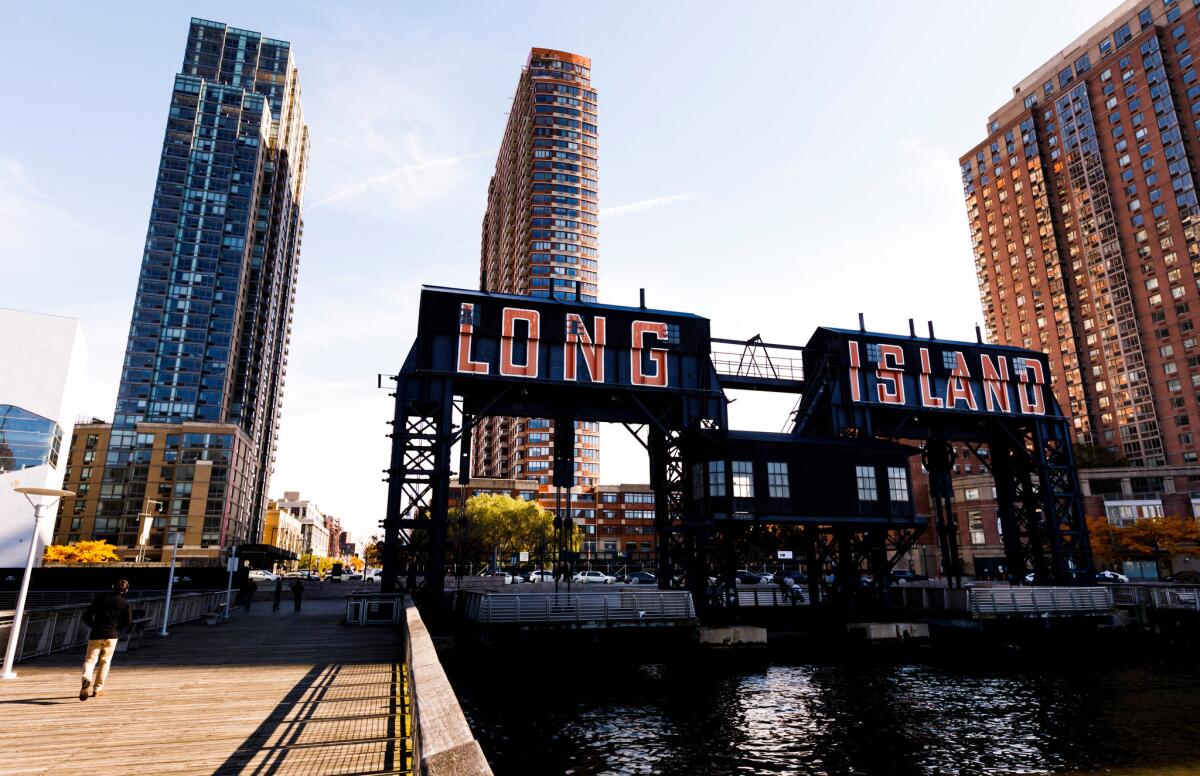Jeff Bezos was jealous of Elon Musk. So Amazon’s HQ2 team fell victim to hubris

- Share via
When Elon Musk secured $1.3 billion from Nevada in 2014 to open a gigantic battery plant, Jeff Bezos noticed.
In meetings, the Amazon.com Inc. chief expressed envy for how Musk had pitted five Western states against one another in a bidding war for thousands of manufacturing jobs; he wondered why Amazon was OK with accepting comparatively trifling incentives. It was a theme Bezos returned to often, according to four people privy to his thinking. Then in 2017, an Amazon executive sent around a congratulatory email lauding his team for landing $40 million in government incentives to build a $1.5-billion air hub near Cincinnati. The paltry sum irked Bezos, the people say, and made him even more determined to try something new.
And so, when Amazon launched a bakeoff for a second headquarters in September 2017, the company made plain that it was looking for government handouts in exchange for a pledge to invest $5 billion and hire 50,000 people. The splashy reality-television-style contest generated breathless media coverage, attracted fawning bids from 238 cities across North America and ended with Amazon deciding to split the so-called HQ2 between New York and Virginia. Then progressive politicians attacked the $3 billion in incentives offered by New York, and Bezos pulled out. Amazon was widely ridiculed for its failure to court New York politicians.
To understand why that happened, Bloomberg interviewed 12 people familiar with Amazon’s effort. Their story, outlined here for the first time, depicts a team that became the victim of its own hubris. Bezos’ frustration with what he deemed meager government largess prompted executives to scrap lessons learned through the years in favor of an unapologetic appeal for tax breaks and other incentives.
Employees with experience negotiating deals around the country anticipated problems, but their red flags were ignored by those eager to please Bezos with a new playbook for a big win. Secretive and walled off from the rest of the company, according to people familiar with the situation, the HQ2 team members marinated in the headlines and hoopla and persuaded themselves Amazon would be welcomed anywhere.
That blinkered assumption continues to resonate today, not least among city officials across the continent who felt manipulated by Amazon, according to people familiar with their thinking. Meanwhile, a bipartisan group of state lawmakers is considering a nonaggression pact to halt the kind of tax-incentive bidding war unleashed during the HQ2 process.
“This entire thing was an ego exercise that blew up in Jeff Bezos’ face,” says one of the people.

In an emailed statement, Amazon said the company has invested $270 billion in 40 states and created more than 500,000 jobs with competitive wages, benefits and employee training. “We partner with hundreds of communities across the country to bring them new jobs and investment. Like many other companies, we are eligible to access incentive programs created and regulated by cities and states to attract new investors — as they know that these investments pay a long-term dividend in the form of jobs, new economic opportunity, and incremental tax revenue.”
For years, Amazon’s economic development team followed a well-trod process, dubbed the “welcome wagon” internally and developed as the company began building warehouses in towns and cities around the U.S. To head off concerns about traffic, working conditions and competition with local mom-and-pop shops, executives hosted informational meetings, inviting residents and stakeholders to ask questions. Sometimes, Amazon arranged for officials to travel to other cities to see its warehouses firsthand and speak with employees and local leaders. All the while, the public-relations team cultivated relationships with advocates willing to tell the media why they favored the project.
Windsor, Conn., Mayor Don Trinks recalls how Amazon eased anxieties in his town near Hartford before opening a warehouse there in 2016. When news of the project broke, residents panicked about truck traffic. Amazon hosted meetings around town and answered every question.
“The public perception was a big company like Amazon will come in and steamroll our little town, but nothing could’ve been further from the truth,” says Trinks, who has been mayor for almost 20 years and owns a small restaurant. “Their outreach was very impressive. They took the hard questions and jumped right in front of everything.”
Bezos decided the HQ2 process would be handled differently. It wasn’t just Musk’s Nevada experience that got him fixated on extracting more government subsidies. He had also watched Boeing Co. win an $8.7-billion handout from Washington state in 2013 — only to scale back its workforce over the next several years. Meanwhile, Amazon was getting no state money despite hiring thousands of people and was tangling with the Seattle City Council, which blamed the company for making the city too expensive.
Besides angling for government generosity for HQ2, Bezos also told his team to seek $1 billion in breaks for other Amazon projects, according to someone familiar with the situation. The economic development team had failed to meet its financial targets in each of the previous several years, the person says. (The Wall Street Journal first reported the $1-billion target.) An Amazon spokeswoman disputed that the company has goals for government incentives.
The notion of a second headquarters grew out of the realization that, over the years, Amazon had opened satellite offices around the country with little rhyme or reason, according to a person close to the process. Bezos’ senior executives decided it would be better to pick one location that could absorb headcount needs for the next decade. Amazon had been quietly scouting cities and had already identified 25 that could accommodate about 20,000 employees, according to the people. The company could have whittled down that list and negotiated with select finalists.
Instead, Bezos pushed for the bakeoff. Musk had enticed five states into a bidding war; Bezos would open his contest to all of North America, even if putting a second HQ in Canada or Columbus, Ohio, was unlikely.

A team that included real estate chief John Schoettler drew up a request for proposals, highlighting such must-haves as an airport with direct flights to Seattle and good universities. The word “incentive” was used 21 times. Some team members cringed, worried that Amazon would come across as tone-deaf given Bezos’ wealth, not to mention triggering a national debate over income inequality. They knew officials would offer tax breaks regardless. Demanding them left Amazon exposed to accusations of corporate greed.
But the naysayers were quickly hushed and sent to work on other projects. The remaining members of the team believed any fallout would be short-lived and overshadowed by the sheer size of Amazon’s investment.
Led by public policy chief Brian Huseman and economic development director Holly Sullivan, the HQ2 team commandeered a small Washington office and retreated behind a wall of secrecy. The windows were blacked out, and Huseman warned non-team members that anyone entering the room would be punished, according to one of the people. Information was tightly controlled to prevent leaks.
One evening in January 2018, members of the team got an email ordering them to report to the office early the next morning. It was time to trim the list of more than 200 HQ2 contenders. Huseman reminded the team that anyone leaking information to the media would be identified and fired. They each got a stack of cities to call and instructions to let the officials down gently by telling them that they had submitted an enticing proposal.
Despite Amazon’s efforts to keep the operation contained internally, the fallout spilled into other departments. City and state officials privately complained to their Amazon contacts that the exercise was a tremendous waste of public resources, according to a person who received the complaints. The frustration spread beyond North America after Amazon’s bid for big tax breaks became international news. One Amazon executive warned that officials in Europe where the company was trying to expand were asking how long it would be before Bezosasked them for tax breaks as well.
In September 2018, executives decided to split the new headquarters between New York and Virginia. Before going public, Amazon quietly tied up real estate deals and government agreements in the two locations, mindful that local real estate prices could spike if the media got wind of it. The prioritization of secrecy over building alliances proved fatal in New York. When the news finally leaked, Councilman Jimmy Van Bramer’s phone lighted up. Van Bramer was supportive of efforts to draw Amazon, but quickly became an opponent once he realized that Amazon, Gov. Andrew Cuomo and Mayor Bill de Blasio had cut him and other local officials out of the process. Van Bramer sought clarity from the governor and mayor but says he was ghosted and misled. His ire increased upon learning that there were no plans to seek city council approval.
He was further incensed upon learning of the subsidies Amazon would receive, including a $500-million grant to help pay for the new headquarters. That week, Van Bramer traveled to Puerto Rico, where he bumped into New York state Sen. Michael Gianaris in the lobby of the El San Juan Hotel. Over a Medalla beer, they vented and agreed to fight the project. The pair got help from the Retail, Wholesale and Department Store Union, which has long considered Amazon’s online shopping business a threat to its members. Fueling the tension was a new Amazon warehouse in Staten Island where some workers wanted to organize.
Amazon representatives sought meetings with city and state officials, but Gianaris declined and Van Bramer met with them only once, according to an Amazon executive familiar with the process. This person says Amazon didn’t involve the City Council because getting approval would have taken years and because other major projects such as the Hudson Yards redevelopment had gone through the state. Moreover, this person says, Amazon representatives received a warm welcome during a site visit.
The extent of the hostility didn’t reveal itself until Huseman appeared before the city council in December 2018, where he was jeered and interrupted. Back in Seattle, Amazonians watched the livestream in disbelief, texting one another about how Huseman came off as robotic, inauthentic and out of touch. Huseman fell back on job figures and dollar signs but there wasn’t enough to humanize the project.
The ultimate breaking point came when Huseman said the company wouldn’t remain neutral if employees tried to organize unions. He appeared oblivious to the political climate in New York, where the children of union janitors and laborers get elected to run the city. Amazon’s negotiating strategy, internally summarized as “Too bad. We’re Amazon,” had met its match.

The beginning of the end came when Gianaris was recommended for a seat on the state’s Public Authorities Control Board, which had the power to influence the deal. Gianaris was never confirmed for the seat, but his nomination was a game changer. Gianaris says he requested the appointment because “the Amazon project was in my district, and I saw this as the only tool available to have any real input into what was about to go down.”
There were some last-minute meetings to attempt to bridge the divide and even some whispers that Amazon had capitulated and agreed to remain neutral in employee union campaigns. Amazon saved the breakup news for Valentine’s Day, saying that “a number of state and local politicians have made it clear that they oppose our presence and will not work with us to build the type of relationships that are required to go forward with the project.”
Looking back, some Amazon employees say they shouldn’t have blindly assumed that Amazon would be welcomed everywhere, but still see signs of success in the 25,000 jobs to come in Virginia and 5,000 in Nashville. Others involved in the process say executives tied their hands by prioritizing secrecy over relationship-building.
“Negotiating incentives is easy,” one says. “What’s hard is winning hearts and minds and Amazon didn’t do anything to win hearts and minds.”
Still, Bezos can take comfort from one aspect of the HQ2 saga. Thanks to $762 million in incentives from Virginia, according to the watchdog group Good Jobs First, Amazon is just $100 million shy of the $2.4 billion Tesla has amassed in handouts.
More to Read
Inside the business of entertainment
The Wide Shot brings you news, analysis and insights on everything from streaming wars to production — and what it all means for the future.
You may occasionally receive promotional content from the Los Angeles Times.










